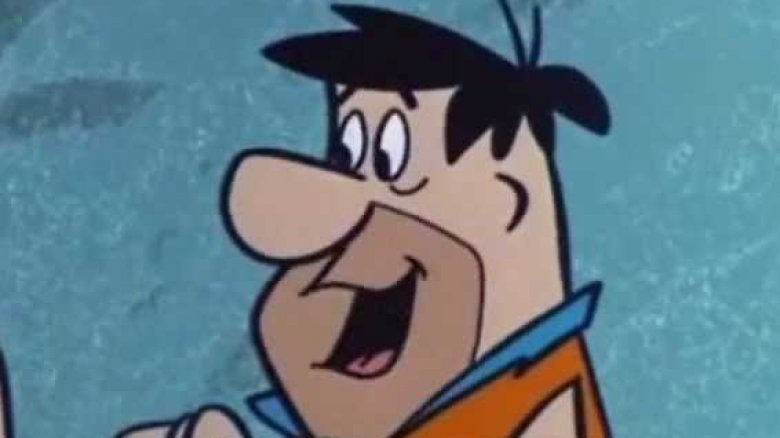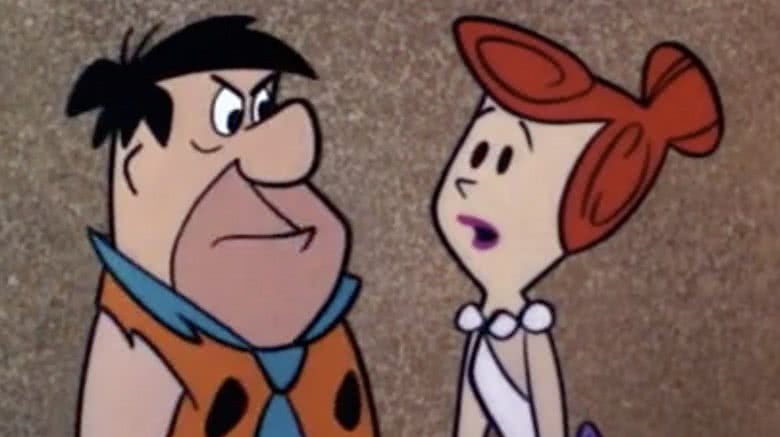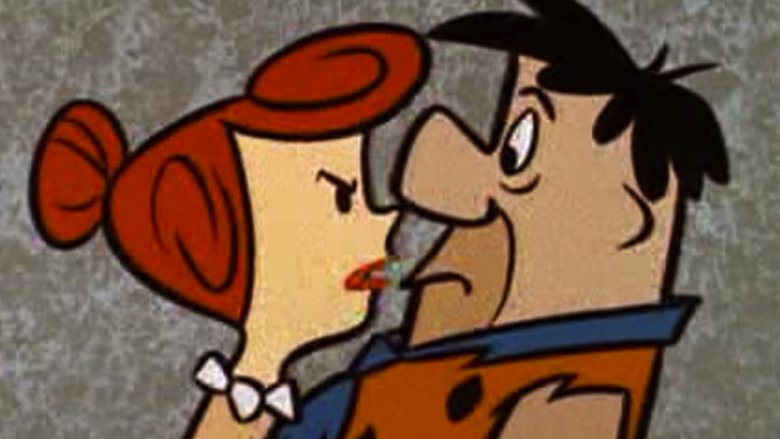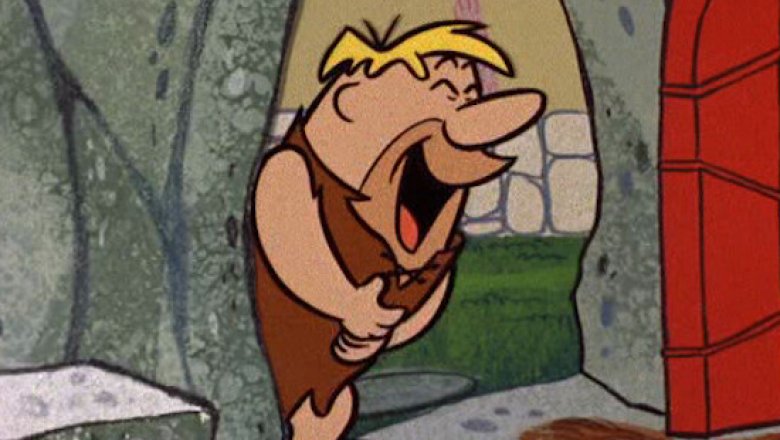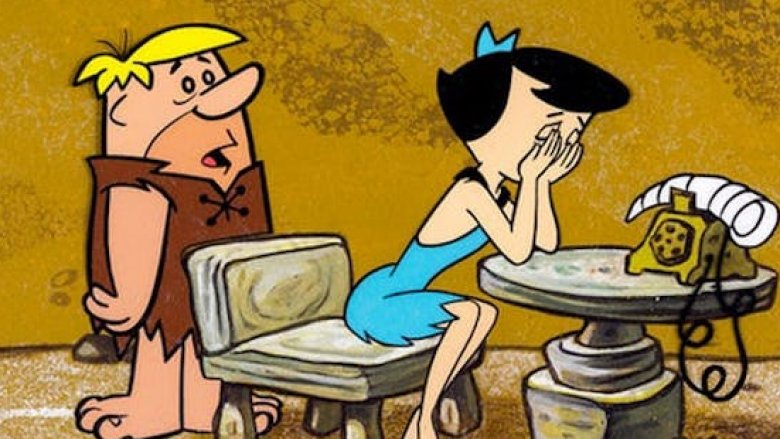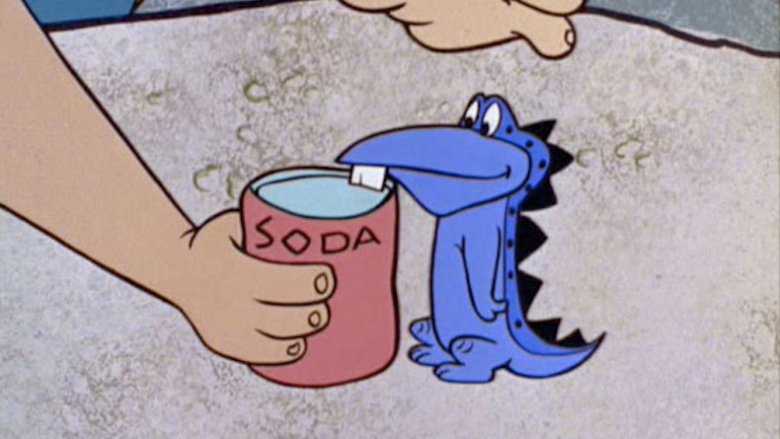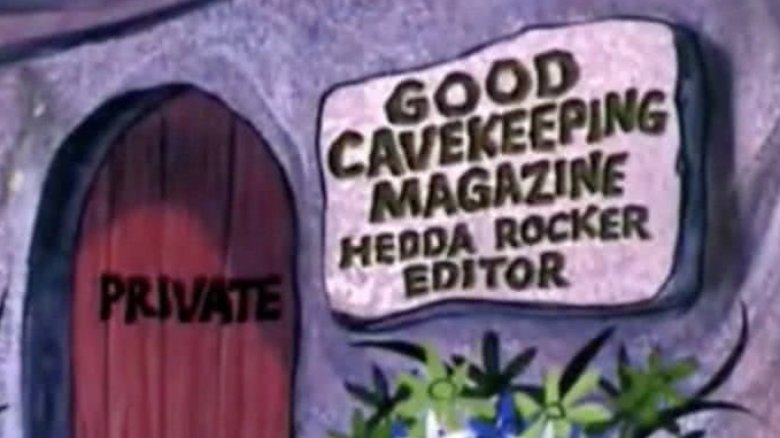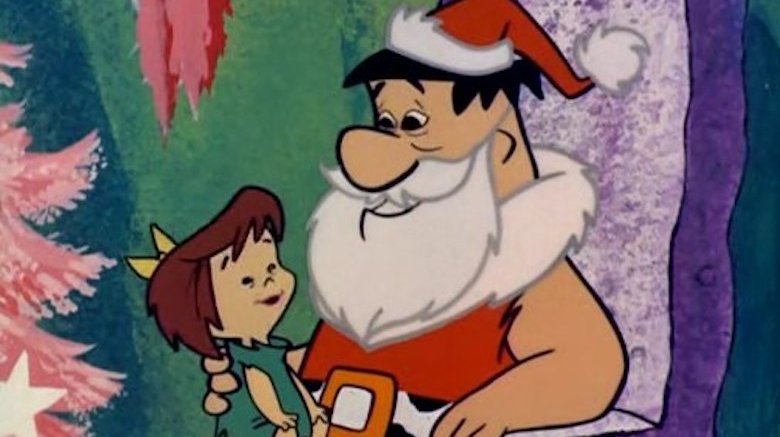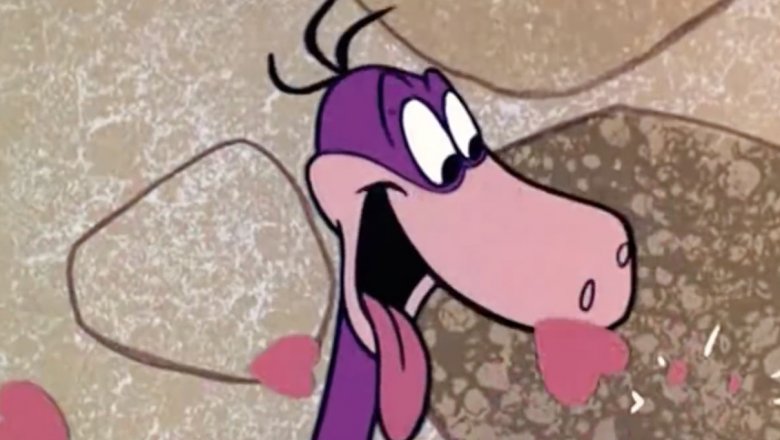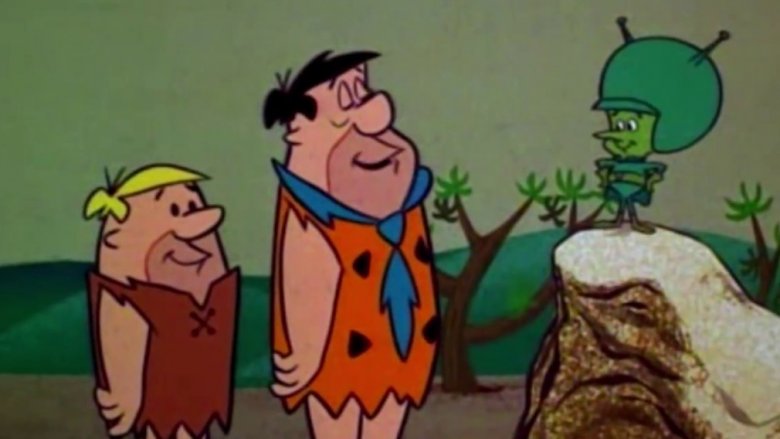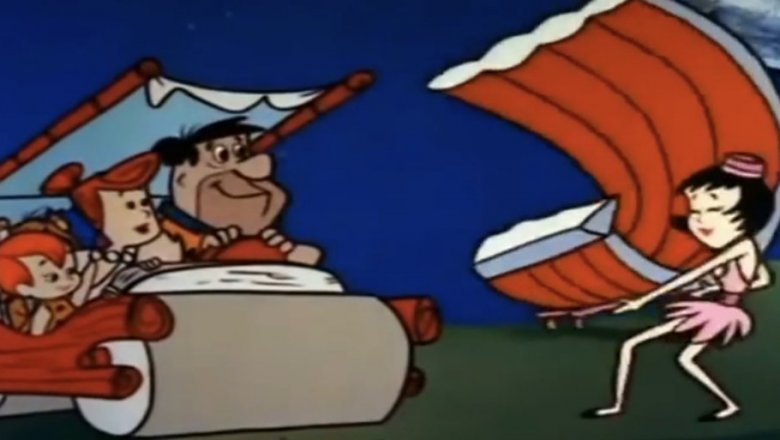Things Only Adults Notice In The Flintstones
As the famous theme song goes, the Flintstones are the modern Stone Age family from the town of Bedrock. The continuing adventures of Fred and Wilma Flintstone, Barney and Betty Rubble, their kids and their prehistoric animals was a pop culture sensation upon its debut in 1960, as it was one of the first animated series to air in primetime television. The characters were so charming and their situations so relatable (even though they took place thousands of years ago and happened to people who pedaled their cars and kept dinosaurs for pets) that it never faded away. Multiple spinoffs, merchandise, big-screen adaptations, and endless reruns of the show's six seasons of episodes ensured a place in history for The Flintstones.
Each new generation of kids can't help but come across a few old installments of The Flintstones, and they'll get plenty of cartoon antics to enjoy. But viewing the show through adult eyes reveals a complex world with a lot of dark or problematic moments. You wouldn't notice them if you're a kid, but if you're a grown up... you yabba-dabba-do. These are the things only adults notice in The Flintstones.
The Flintstonemooners
Name a TV character — not Fred Flintstone — who's heavyset, loud, boorish, underemployed, and set in his ways. TV viewers under the age of 40 would probably answer "Homer Simpson." Older people might say "Ralph Kramden," the blustery bus driver played by Jackie Gleason in a series of comedy sketches in the 1950s and then the standalone series The Honeymooners. The Flintstones is clearly based on The Honeymooners, a show that is similarly tame enough for primetime broadcast television in buttoned-up mid-century America, but squarely aimed at an adult audience. Kids watching The Flintstones today would not pick up on the show's implicit and explicit references to its TV predecessor, but grown-ups both now and during its original run definitely would. There are lots of similarities. For example, Ralph is a blue-collar guy who ekes out a living driving a bus (while Fred works down at the rock quarry driving a dinosaur). He comes home each night to his grimy apartment where he lives — and constantly butts heads with — his long-suffering wife, Alice (just like Fred and Wilma argue all the time). His neighbor and best friend is a guy named Ed Norton, portrayed by Art Carney... who sounds exactly like Barney Rubble.
There's a lot of domestic abuse
While The Flintstones is clearly a remake of The Honeymooners, albeit an animated one set in prehistoric times, it does make a few notable changes. For example, Barney Rubble doesn't wear a hat or a vest like his predecessor, Ed Norton. Also, the show is a bit more of an equal opportunity offender when it comes to domestic abuse. Ralph Kramden (Jackie Gleason) threatened to beat his wife (Audrey Meadows) so often that his verbal promise of violence became an enduring TV catchphrase: "One of these days, Alice — boom! Straight to the moon!" Audiences never actually saw Ralph strike his wife with enough force to knock her out of Earth's gravitational pull, but viewers of The Flintstones — kids, mostly — often saw it work the other way around. Fred often threatened to hit Wilma, but he never actually did. But Wilma? When Fred did something she didn't like — which was often — she'd clock him in the head.
Her abuse manifests in less aggressive forms, too. In the show's closing credits, the Flintstones' pet tiger locks Fred out of the house at night, and Fred bellows "Wilma!" hoping to be let back in. Fred is loud, and there is obviously no glass in the home's windows, so Wilma definitely hears him... but leaves him there to spend the night outside.
Lots of adult humor in a kid-friendly show
The Flintstones is a cartoon, and it passed strict network standards in the conservative early 1960s, but that doesn't mean it's necessarily a show for children. This was a show about adults, for adults, and it catered to adults with episodes about adult problems. It also snuck in the occasional dirty joke, ones that grown-up viewers would understand but which would sail over the heads of the young and impressionable kids at home. (And, it would seem, the ABC censors.)
In one episode, Fred and Barney go to a costumer, and Fred asks Barney, "What kind of costume you gonna get?" Barney, a short guy, replies that he's looking for "something that makes me look tall." Fred cracks, "How 'bout another head?" and makes himself laugh. Barney's snappy and filthy comeback: "Another one? What do I need three of them for?" (See, he has one head on top of his body, and another one, uh, lower down.) Another time, Fred and Barney are watching sports on TV at the latter's house when they lose reception. Fred inquires if everything is in working order, including asking, "How's your antenna?" Barney replies, with a huge, self-satisfied grin, "Fine, friend, how's yours?"
It would also seem that they had "adult films" in the Stone Age, per a comment Fred makes in the special Fred's Final Fling. While getting a check-up, a doctor holds up Fred's x-ray, prompting Flintstone to joke, "How 'bout it, Doc? Flintstone in an x-ray-ted picture!"
Betty and Barney struggled with infertility
For a show that debuted in the relative social Stone Age, The Flintstones is surprisingly progressive and open about a number of issues. Kids watching these old episodes today would think nothing of a TV couple discussing their biggest problems, because that's simply what TV couples do nowadays. But in 1960, it was downright revolutionary if not de-stigmatizing that The Flintstones was open about how Barney and Betty Rubble couldn't naturally conceive a child like the Flintstones, and that they were sad about it.
It was a major TV event in February 1963 when Wilma gave birth to Pebbles, and afterwards, the Rubbles spend an inordinate amount of time hanging out with the new arrival — they just want a baby so bad. Since they can't, they try to family plan another way: Heartbreakingly, as a last resort, they make a wish on a falling star. The next morning, their wish has apparently been granted in the form of a supernaturally strong baby named Bamm Bamm, left in a basket outside their front door. As if this couple hasn't been through enough — adult viewers will certainly feel some empathy — they have to jump through a lot of hoops to legally adopt the kid, and are only granted custody at the last minute. The whole ordeal unnerves and mentally drains Barney to the point where he tries to commit suicide, only to be stopped by Fred. Having fun yet, kids?
Beastly behavior
The Flintstones wouldn't be The Flintstones if not for one of its most amusing conventions: animals, birds, and other Stone Age creatures performing all kinds of household and mechanical tasks. The human characters of The Flintstones seem to have a living thing for every job — an elephant and its water-filled tusk instead of a garden hose, an actual rabbit's ears for a TV's antenna extension (nicknamed "rabbit ears"), a swordfish for a kitchen knife, and a porcupine serving as a pincushion, to name a few examples.
Often, that animal will break the fourth wall and make some weary comment about the back-breaking nature of the work. It doesn't seem like the animals on The Flintstones are getting paid, or have any freedom whatsoever. They have to stick around the house in case Fred or Wilma need them. In other words, the humans of The Flintstones have enslaved animals, forcing all creatures great and small into a being a beast of burden of some variety. While this is cruel, some animals have it worse than others. The end-of-day whistle at Fred's place of work is a bird, and he makes his sound when a guy yanks hard on his tail. A poor pelican serves as a trash can, meaning people just force-feed it literal garbage.
These puns don't rock
Probably the most memorable (and notorious) aspect of the world of The Flintstones is how nearly ever person, place, and thing has some kind of rock pun for a name. Some work better than others — Fred Flintstone works for a guy named Mr. Slate, and he and Wilma take a trip to sunny Rockapulco. The series is so committed to this running gag, however, that writers often had to force puns, resulting in Flintstones rock gags that don't quite work, leaving young viewers out completely and adults left to figure out exactly what the joke is supposed to be. (Yes, Jackie Kennerock is supposed to be Jackie Kennedy, and Clark Gravel is a send-up of Clark Gable.)
It's an even bigger problem when it comes to the show's dated pop culture references. Actual celebrities of the early 20th century were parodied and given rocky pun names. Some of these references have not stood the test of time, making it nearly impossible for kids to know what's going on. For example, would they have any idea that "Sandy Stoneaxe" is a riff on pitcher Sandy Koufax, or that Rock Pile Hudstone is teasing Rock Hudson?
Christmas in the Stone Age?
Kids tend to let the world of a show wash over them. It's much easier for young viewers to instantly suspend their disbelief and accept and enjoy a show for what it is, on its surface level. By virtue of being alive and dealing with the realities of the world longer, adults can't help but have a critical eye, and critique even a cartoon show from the 1960s. For example, kids just don't care that the Flintstones on The Flintstones live a relatively modern life. Sure, they've got animals that do the jobs that mechanical devices perform in the 21st century, but they've also got things like TV, the radio, movies, and fast food. This can make an adult question the very nature of the world of The Flintstones, and how they came to possess such technology.
There's a fan theory that posits The Flintstones takes place not in the distant past but the distant future, after an apocalypse has destroyed life as we know it and plunged the world into a new Stone Age, leaving survivors to re-create the world left behind with what they have available, such as animals and rocks. Lending credence to that theory: The Flintstones celebrate Christmas. That holiday is centered on the birth of Jesus Christ, which is believed to have happened about 2,000 years ago, or several thousand years after the Stone Age world of The Flintstones.
Dino the dinosaur: deadbeat dad?
Like most sitcoms of the 1960s, The Flintstones was not serialized. Each episode completely stood on its own, with Fred, Wilma, Barney, and the rest getting into some kind of sticky situation and resolving it by the end of the episode, resetting everything back to square one for the next episode, for six seasons. Kids can accept this — they can compartmentalize and enjoy shows on the surface level. Adults, well-versed in consequences and the relationship between cause and effect, may want to know more about developments in the Flintstones universe — such as what happens ever the events in the episode "Dino and Juliet."
In this comic version of Romeo and Juliet (a Shakespeare reference — there's one more thing kids won't think about) Fred Flintstone and a new neighbor get into a heated dispute, just like the Montagues and the Capulets. Also mirroring the very old play: Instead of the warring factions' teenage offspring falling in love, their pet dinosaurs do. Dino falls instantly head over heels for Juliet, the cute new sauropod in town (who looks a lot like Dino, but smaller and rocking a bow and a pearl necklace). As lovers are wont to do, Dino and Juliet steal away to be physically intimate, resulting in the birth of more than a dozen babies. Never again on The Flintstones are Juliet or her children with Dino seen. Apparently, he's a love-'em-and-leave-'em type and an absentee father.
The Great Gazoo is a great big problem
After a few years on the air, when a show's little kids aren't little anymore and the writers are running out of ideas and the ratings are falling, sitcoms tend to bring in a new character to breathe new life into the series. Homeless teen Luke showed up on Growing Pains, Cousin Oliver appeared on The Brady Bunch, and The Simpsons mocked the idea with a random new character named Roy. One of the first examples of this phenomenon is the 1965 arrival of a tiny, green, smug alien named the Great Gazoo on The Flintstones. Adults with a passing knowledge of TV history will recognize this desperate attempt by Flintstones writers to generate new plots, as well as how it's completely baffling. All of a sudden, a domestic sitcom set in the Stone Age is also a science fiction series?
It gets weirder, and darker: He's been sent through space and time to prehistoric Earth as a punishment after making a doomsday device on his home planet. Fred and Barney discover him and rather than turn him into the government or something, they befriend him, although he mainly seems to call them "dumb-dumbs" and magically disappear whenever Fred is talking to him, giving the impression to Wilma that Fred is talking to himself, and is thus insane. Or Maybe the Great Gazoo isn't real at all, and Fred and Barney (and Pebbles, who spots him on occasion) are the victims of some kind of ancient gas leak.
Pet peeve
Older, more astute viewers may notice from the opening credits of The Flintstones that the humans and dinosaurs on this show enjoy a confusingly inconsistent relationship. The sequence begins with Fred ending his day of work at the rock quarry, sitting in a little control cab atop a dinosaur acting as a beast of burden and a stand-in for a piece of modern-day construction machinery. When the whistle (or a bird, rather) blows and Fred is free, he slides down the back of the dinosaur (which can't be pleasant for the animal) and races home to grab his family, including Dino, the family's pet dinosaur.
This dinosaur acts and is treated differently — he's more or less the Flintstones' dog, as he's a lovable barking and licking machine. So while some dinosaurs are made to break rocks and treated as slides, others get to live inside homes like people? (Even the Flintstones' pet sabertooth tiger is made to sleep outside.) Things get more confusing and ghoulish in the end credits, when, after leaving a drive-in movie, Fred drives the gang to Bronto Burgers and Ribs, where he orders their signature dish: brontosaurus ribs, so large that they tip over his car. Fred is apparently going to eat a big piece of the same type of animal he works with all day and considers a member of his family... and in front of Dino, no less.
